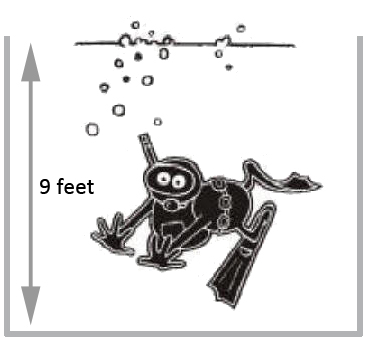
Robert L. Sands is uniquely qualified to comment on the science relating to the inflatable chambers. For three years Sands administered research and development for the Commonwealth of Australia and his first hyperbaric chamber patent application was lodged in 1983 for an inflatable chamber.
Sands abandoned the inflatable concept after expending considerable resources and went on to design and build chambers in the “conventional” manner meeting American Society of Mechanical Engineers, Pressure Vessels for Human Occupancy (ASME PVHO-1) standards.
Simply put, the inflatable chamber could not meet the pressure requirements to treat certain maladies and traumas, particularly those encountered in diving, aviation and bio-warfare response.
Sands eventually designed and developed the revolutionary transportable recompression chamber system that is currently in fleet-wide use with the U.S. Navy, Marine Corps and Coast Guard. Sands holds the patent for that transportable chamber system.
Sands, a founder of Healing Chambers International Inc, is a prolific author and travels nationally and internationally lecturing about HBOT medicine. Click here to view CV
Below is an extract from his forthcoming book Oxygen – The First Medicine – Cool Change Press.
Hyperbaric Oxygen Therapy
Dispelling the confusion and controversy over ”Hard“ or ”Soft“ HBOT chambers
A recent headline appeared in the Autism Research Institute (ARI) newsletter:
“Center for Autism and Related Disorders Study Finds Hyperbaric Oxygen Therapy Ineffective Treatment for Children with Autism”.
The accompanying article reported on a recent randomized trial conducted by respected specialist physicians Dr. Jeffery Bradstreet and Dr. Doreen Granpeesheh. Around the same time, I received this little note from respected autism researcher Kerri Rivera discussing a young patient at her hyperbaric oxygen center in Puerto Vallarta:
“I didn’t tell you what happened in our chamber two weeks ago. The parents of a five-year-old nonverbal non-autistic girl came to see what I could do for her. So…guess what happened?! The child who never spoke a word in her life began speaking in the chamber on her first session! We were all blown away. Thank you for such a great blessing.”
Exciting results such as those that Kerri describes are commonplace at our Healing Chambers International hyperbaric oxygen therapy (HBOT) centers. We use HBOT “hard” hospital grade as an adjunct to the many therapies required to normalize patients and consistently achieve favorable outcomes. So, why the discouraging report in the ARI newsletter?
Main Category: Autism
Also Included In: Clinical Trials / Drug Trials
Article Date: 11 Nov 2009 – 2:00 PST
Click here to see that ‘Soft’ inflatable chambers are useless for children
Not All HBOT Chambers Are Created Equal
The importance of oxygen percentages
When we look closely at the above study reported in the ARI newsletter, we find that the researchers at the Center for Autism and Related Disorders, Inc. (CARD) only worked with the inflatable low-pressure “mild” chambers which are known in the field as mHBOT.
Their report, entitled The Randomized Trial of Hyperbaric Oxygen Therapy for Children with Autism, describes HBOT as “consisting of 24% oxygen delivered at 1.3 atmospheres of pressure” and they find it “does not have a significant effect on symptoms of autism.”
But — and here’s the important point — the research on soft chambers should not be generalized to the efficacy of hard chambers. True, many clinicians and parents who have purchased these inflatable low-pressure chambers would vigorously dispute this study. Nonetheless, the positive anecdotal reports and scientific data documented in both SPECT and PET scans involve children treated in hospital grade hard chambers where 100% oxygen is administered at a higher pressure.As you can see, mHBOT and HBOT are not quite the same thing. The pacing of good outcomes and the results they produce are as different as a automobile is from a Bell Jet-Ranger helicopter. If you want to take a journey back to good health, which one gets you there faster? …
It is all about science
In particular, three laws of physics known as the Universal Gas Laws. Boyle’s, Dalton’s and Henry’s laws – linked at all times together, they become Universal. Alter or tweak any one and the other two adjust to keep pace. Henry’s seems the most prominent in HBOT because “gas becomes soluble according to its partial pressure.” Henry’s Law is the explanation of how carbon dioxide melts into a soda, fizzing back into a gas when the bottle or can is popped open. Likewise, oxygen obeys these same gas laws and melts into the liquid human body when there is an increase in its partial pressure or density. The additional dissolved oxygen acts as an energy catapult and vigorously increases cellular oxidative metabolism, promoting healing and repair. Thus the growing popularity of hyperbaric (high density or dosage) oxygen therapy, or “HBOT.”There are two ways to dissolve additional oxygen into the body. One is tinkering with the percentages of oxygen in the air we breathe. The other is to put the patient in a pressure chamber and increase the amount of molecules of oxygen or density.
Adjusting the oxygen percentage
The air we breathe is approximately 80% nitrogen with the balance oxygen – about 20%. According to Dalton’s Law, we can increase partial pressures (density) of oxygen by altering the percentage of oxygen in the air we breathe. Paramedics carry oxygen all of the time to do just that. By giving a casualty 90% oxygen Dalton’s Law dramatically kicks up the density (partial pressure) or the amount of oxygen molecules in each lungful and Henry’s Law keeps pace. The extra oxygen gaseous molecules dissolves and the dense oxygen, now chemical molecules, flood into plasma and clear fluids, easing the burden on the heart. The Universal Gas Laws are always working, saving many lives each day.
A paramedic’s sophisticated oxygen set-up to get this extra oxygen into the body is not the only way. Here are some low cost alternatives … Nasal prongs increase oxygen partial pressure from normal air 20% to 36%
Hudson masks increase oxygen partial pressure from normal air 20% to 50%
Adjusting with PRESSURE plus oxygen percentage
To supersaturate the body, you do need a pressure vessel, commonly known as HBOT chambers. This extra pressure (Boyles’s Law) dramatically alters Dalton’s and Henry’s Law.
In hospital-quality HBOT chambers all patients breathe 100% medical-grade oxygen. All of these chambers reach pressures of 15 psig at minimum, some of these chambers can reach pressures of 100 psig.
The Universal Gas Laws produce healing miracles in chambers that have 100% oxygen and correct pressure (or oxygen density) capability. Remember, pressure = density and the density = the dose.
Different illnesses require different treatment pressures. The “one size fits all” just is not so in a hyperbaric chamber because there is a distinct drug-dose response by the patient. Just as with prescription drugs, it is the physician who makes the dosage decision, the technicians operating the chambers merely dispense the high dosage oxygen according to orders.
To illustrate this, a couple of examples are appropriate. In such a hospital HBOT chamber, gas-gangrene is treated at 29 psig (3 ATA) of 100% oxygen. This provides the patient almost 16 times the partial pressure of oxygen of breathing room air at sea-level Diabetic ulcers respond to 19 psig (2.3 ATA) and heal quickly. Lyme disease and chronic fatigue syndrome patients need the same pressures to achieve a positive result. The inflatable fails to deliver both the required treatment pressure and oxygen percentages for these health problems.
The inflatable is pressurized to a mere 4 pounds per square inch (“psig.”) By adding 4 psig air pressure, the oxygen density (partial pressure) jump from 20% to 26%.
There is only one soft-sided chamber in the World that is not a ‘faux’ chamber – the British SOS Hyperlite designed and built by John Selby.
This chamber is pressurized by pure filtered medical air (SCUBA) and there is zero chance of contamination within the compartment of contaminants such as carbon monoxide “CO”), pyrolosis products, bio-warfare agents. [1]
In fact, as Robert L Sands once stated, “it has the performance better than many hard walled chambers. The difference between a soft walled chamber and a Hyperlite is equivalent to the difference between a coffee table and a Bell Jet Ranger helicopter.” [2]
For more information on this particular product, please visit www.hyperlite.co.uk
About the Inflatable Chamber
Identical partial pressures of oxygen occur if you spend an hour at the bottom of a 9 foot deep swimming pool breathing from a SCUBA tank – and the physiological changes to the human body are virtually the same!
As an FDA Class II medical device, whether the bag is full of air or oxygen, a licensed physician or dental surgeons’ prescription is mandatory for any use. While many chiropractors and other health practitioners have great skills, the law is the law. Despite their skills, they cannot write that prescription.
You MUST have a prescription from a physician (M.D. or D.O.) or a dental surgeon (D.D.S.) to purchase an inflatable chamber.
Referring to the air-filled chamber as “mild” hyperbaric oxygen therapy (mHBOT) does not erase FDA rulings.
Chiropractors (D.C.), naturopathic doctors (N.D.), or any other practitioners, are breaking the law if they prescribe mild hyperbarics and face arrest by their local district attorney.
Unfortunately, so too are any well-meaning caregivers that allow others to use their personal inflatable chambers.

Code Compliance – The local fire department
In addition to the FDA rules, the local fire marshal will insist that any clinic that uses hyperbaric chambers comply National Fire Protection Agency (NFPA) 99-11 codes with fire walls and certified fire doors, sprinklers and other code compliance. Eleven States and three U.S. cities are now enforcing the PVHO-1 codes and scrutinizing health care practitioners who advertise for patients.[1] Reproduced from the private written correspondence of R L Sands [2] Reproduced from the private email correspondence of R L Sands


